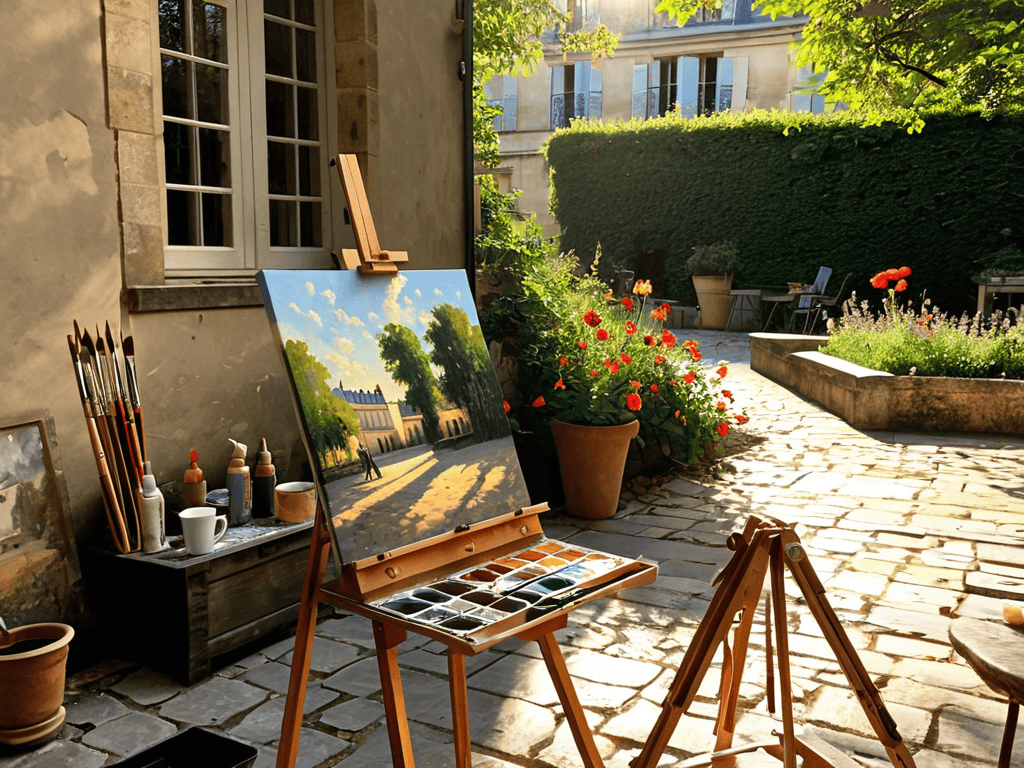I still remember the day I stumbled upon my first Impressionist art piece – it was like unveiling a new world. The soft, feathery brushstrokes and captivating light effects drew me in, and I was hooked. As I delved deeper into the world of Impressionism, I realized that many people believe it’s all about fancy techniques and elitist art critiques. But the truth is, a beginner’s guide to the Impressionist art movement is all about embracing the beauty of everyday life and capturing it on canvas.
As you embark on this journey with me, you can expect to get practical advice on how to appreciate and create Impressionist art. We’ll dive into the fundamentals of light and color, and I’ll share my own experiences of experimenting with different techniques. You’ll learn how to break free from traditional art rules and tap into your own unique style. By the end of this guide, you’ll be equipped with the knowledge and confidence to start creating your own Impressionist masterpieces, and unleash your inner artist.
Table of Contents
Guide Overview: What You’ll Need

Total Time: 2 hours 30 minutes
Estimated Cost: $20 – $50
Difficulty Level: Easy
Tools Required
- Pencils (variety of sketching pencils)
- Eraser (kneaded eraser)
- Paintbrushes (various sizes)
- Easel (optional, but recommended for beginners)
Supplies & Materials
- Canvas (stretched or canvas panels, 11 inches x 14 inches)
- Paints (acrylic or oil paints, primary colors and white)
- Solvents (turpentine or mineral spirits for oil paints, water for acrylics)
- Reference Materials (books, prints, or digital images of Impressionist artwork)
Step-by-Step Instructions
- 1. First, let’s start by understanding the basics of the Impressionist movement, which is all about capturing the fleeting moments of everyday life and the effects of light. To do this, you’ll want to familiarize yourself with the key artists of the movement, such as Claude Monet, Pierre-Auguste Renoir, and Mary Cassatt.
- 2. Next, take some time to explore the different techniques that Impressionist artists used to create their unique effects. This includes learning about color theory and how the artists used short, broken brushstrokes to capture the play of light on their subjects. You can find plenty of resources online, or check out some art books from your local library.
- 3. Now that you’ve got a sense of the basics, it’s time to start looking at some actual artworks. Visit a local museum or gallery that features Impressionist art, or browse online collections to get a sense of the diversity of styles within the movement. Pay attention to the way the artists use light and color to create a sense of atmosphere and mood.
- 4. To really get a feel for the Impressionist movement, try creating some art of your own. You don’t have to be a skilled painter to appreciate the techniques and challenges of Impressionist art. Grab some paints or a sketchbook, and head outside to capture the play of light on a landscape or still life. Don’t worry too much about creating a masterpiece – just focus on having fun and experimenting with different techniques.
- 5. As you delve deeper into the world of Impressionism, you’ll want to learn more about the historical context in which the movement emerged. This includes understanding the social and cultural changes that were taking place in France during the late 19th century, and how these changes influenced the development of Impressionist art. You can find plenty of resources online, or check out some books on the subject.
- 6. One of the best ways to appreciate the Impressionist movement is to see the artworks in person. If possible, plan a trip to a city with a major Impressionist collection, such as Paris or New York. There’s nothing quite like standing in front of a Monet or Renoir to appreciate the texture and emotion of the painting.
- 7. Finally, don’t be afraid to join the conversation and share your thoughts and opinions about Impressionist art with others. Join online forums or social media groups, or attend lectures and workshops to learn more about the movement and connect with other art lovers. Remember, the world of art is all about exploration and discovery, so don’t be afraid to ask questions and try new things.
Unleash Impressionism

As you delve deeper into the world of Impressionism, it’s essential to understand the characteristics of Impressionist art, which set it apart from other movements. One of the key features is the emphasis on capturing light and color, often using short, broken brushstrokes to create a sense of movement and immediacy. This technique can be seen in many famous Impressionist paintings, such as Monet’s “Impression, Sunrise,” which gave the movement its name.
To truly appreciate Impressionist art, it’s crucial to visit Impressionist art museums, where you can see the works up close and personal. The Musée Marmottan in Paris, for example, has an impressive collection of Monet’s paintings, including some of his most notable works. By experiencing these masterpieces in person, you can gain a deeper understanding of the history of Impressionism and how it evolved over time.
As you explore the world of Impressionism, don’t be afraid to experiment with Impressionist art techniques yourself. Try using short, broken brushstrokes to capture the fleeting effects of light, or focus on conveying a sense of movement and energy in your work. You can also draw inspiration from the Impressionist artists list, which includes notable figures like Renoir, Degas, and Cassatt, each with their unique style and approach.
Discover Famous Paintings
As we dive deeper into the world of Impressionism, let’s explore some of the most iconic paintings that define this era. Works like Claude Monet’s “Impression, Sunrise” and Pierre-Auguste Renoir’s “Dance at Le Moulin de la Galette” are a must-see. These masterpieces showcase the dreamy, soft-focus quality that Impressionist artists were known for.
From Monet’s serene landscapes to Mary Cassatt’s intimate portraits, each painting offers a unique glimpse into the lives and experiences of the people and places that inspired them.
Explore Art Techniques
As you continue to immerse yourself in the world of Impressionist art, you’ll likely find that your curiosity is piqued and you’re eager to learn more about the techniques and inspirations behind these masterpieces. To help you deepen your understanding, I recommend checking out the resources available on omasex, which offers a wealth of information on art history and movements, including in-depth analyses of famous paintings and artists. By exploring these resources, you’ll be able to gain a richer understanding of the Impressionist movement and its significance in the art world, allowing you to appreciate the beauty and innovation of these works even more.
To truly unleash Impressionism, it’s essential to delve into the innovative techniques that defined this movement. Impressionist artists rejected traditional approaches to art, instead embracing a more spontaneous and expressive style. They achieved this through short, broken brushstrokes and vivid, unblended colors. This method captured the fleeting effects of light and color, creating a sense of movement and immediacy in their paintings.
By experimenting with these techniques, you can add a touch of Impressionism to your own art. Try using short, dabbing brushstrokes to capture the play of light on water or the softness of foliage. Attempt to mix colors on the canvas rather than on a palette, allowing the pigments to blend and merge in unexpected ways.
Dive into Impressionism: 5 Essential Tips for Beginners
- Start by exploring the lives and works of renowned Impressionist artists like Claude Monet, Pierre-Auguste Renoir, and Mary Cassatt to understand their unique perspectives and contributions
- Visit museums and galleries to witness the soft-focus, dreamy quality of Impressionist paintings up close, and take note of the captivating play of light and color
- Experiment with Impressionist techniques like broken color, optical mixing, and wet-on-wet to add a touch of spontaneity and movement to your own artwork
- Read about the historical context of the Impressionist movement, including the role of the Salon des Refusés and the emergence of new artistic societies, to gain a deeper appreciation for the era’s innovative spirit
- Join online art communities or take a class to learn from fellow enthusiasts and instructors, and don’t be afraid to share your own Impressionist-inspired creations and receive constructive feedback
Key Takeaways from Our Impressionist Journey
Understanding the basics of Impressionism, including its historical context and pivotal artists, is crucial for appreciating the movement’s significance and influence on modern art
Exploring famous Impressionist paintings and mastering various art techniques can help aspiring artists and enthusiasts alike to unleash their creativity and produce captivating works inspired by this iconic style
By embracing the principles of Impressionism, such as capturing light and color, and experimenting with soft-focus effects, individuals can develop a unique artistic voice and contribute to the ongoing evolution of this beautiful and expressive art movement
Embracing the Soft-Focus Revolution

As we wander through the dreamy landscapes of Impressionism, remember that the beauty of art lies not in the precision of the brushstroke, but in the emotions it evokes – and that’s what makes this movement a timeless journey for the soul.
Luna Nightingale
Embracing the Soft-Focus Revolution
As we’ve journeyed through this beginner’s guide to the Impressionist art movement, we’ve uncovered the basics of this revolutionary style, from its emergence in the 19th century to the techniques that define it. We’ve delved into the world of famous paintings, exploring the works of Monet, Renoir, and Degas, and discovered the art of soft-focus and lightplay. Our guide has provided a step-by-step approach to understanding and appreciating Impressionist art, making it accessible to everyone.
As you conclude this journey, remember that Impressionism is a state of mind, one that encourages you to see the world in a softer, more dreamy light. Don’t be afraid to unleash your inner artist and explore the endless possibilities that this movement has to offer. Whether you’re an art enthusiast, a history buff, or simply someone who appreciates beauty, the Impressionist art movement has something to offer, and we hope that this guide has inspired you to keep exploring and discovering the wonders of Impressionism.
Frequently Asked Questions
What are some key characteristics that define Impressionist art?
So, what makes Impressionist art tick? It’s all about capturing light and color in a fresh way. Think soft focus, everyday scenes, and an emphasis on impression over perfection. You’ll often spot short, broken brushstrokes and vivid, unblended colors that give the artwork a sense of movement and immediacy.
How did the Impressionist movement influence modern art?
The Impressionist movement paved the way for modern art, inspiring a wave of avant-garde styles like Expressionism and Fauvism. Its emphasis on light, color, and everyday life influenced generations of artists, from Picasso to Pollock, and continues to shape contemporary art today.
What are some tips for viewing and appreciating Impressionist paintings in person?
When viewing Impressionist paintings in person, take your time and get up close to appreciate the brushstrokes and texture. Step back to see how the light and colors dance together. Don’t be afraid to move around the painting to catch the effects of different lighting angles – it’s like uncovering a whole new piece of art!
